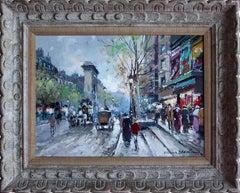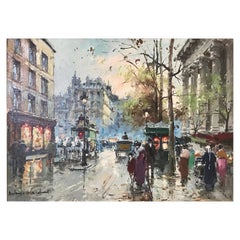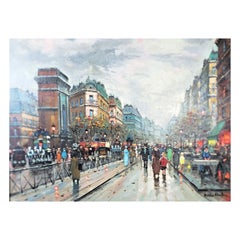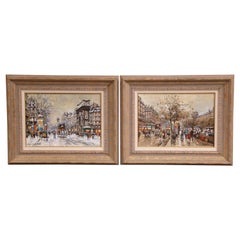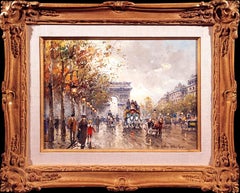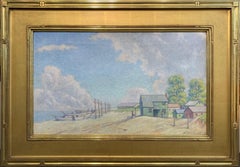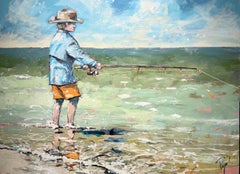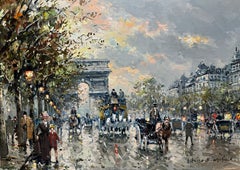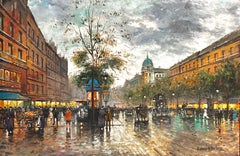Antoine Blanchard Art
French, 1910-1988
Antoine Blanchard (1910-1988) was a French oil painter renowned for his impressionist cityscapes of beautiful Paris.to
1
11
2
14
8
2
2
2
1
1
Les Grands Boulevards et La Porte Saint Denis
By Antoine Blanchard
Located in New York, NY
An exquisite oil painting by renown artist Antoine Blanchards depicting the French street scene Les Grands Boulevards et La Porte Saint Denis. Th...
Category
20th Century Impressionist Antoine Blanchard Art
Materials
Canvas, Oil
Parisian Street Scene. Oil on canvas, 32x46 cm
By Antoine Blanchard
Located in Riga, LV
Parisian Street Scene. Oil on canvas, 32x46 cm
Category
1950s Expressionist Antoine Blanchard Art
Materials
Canvas, Oil
$9,139 Sale Price
20% Off
Antoine Blanchard Boulevard De Capucines, Place De La Madeleine
By Antoine Blanchard
Located in Dallas, TX
Antoine Blanchard (1910 - 1988) Boulevard Des Capucines, Place De La Madeleine. A wonderful and vibrant scene from the Grand Boulevards of Paris under the rain in fall. You can hear ...
Category
1950s Antoine Blanchard Art
Materials
Paint
Antoine Blanchard Original Antique Parisian Street Scene Oil Painting on Canvas
By Antoine Blanchard
Located in Hamilton, Ontario
This large antique origina painting was done by well known Anoine Blanchard of France in approximately 1920 in his signature Impressionistic style. The painting is done with oil pain...
Category
Early 20th Century French Art Deco Antoine Blanchard Art
Materials
Canvas
Pair of Mid-Century Oil on Canvas Parisian Scenes Paintings Signed A. Blanchard
By Antoine Blanchard
Located in Dallas, TX
Decorate a living room or an office with this exquisite pair of paintings. Created in France circa 1960, each artwork is set in a painted frame, and depicts a well known street view of Paris; one composition depicts "Les Quais et Le Louvre" and the other, "La Porte Saint Martin." Both paintings show a realistic rendering of space, and have an impressionistic style with a thick, textured application of paint. The result is one that shows the hand of the artist, and expresses an off-the-moment atmosphere of the place. Both paintings are in excellent condition and are signed in the lower left by the artist, Antoine Blanchard. Authenticity papers will be delivered to the buyer for further authentication.
The present works are currently listed on the Rehs Galleries, Inc., Antoine Blanchard Virtual Checklist, no. LVQLW1318.0010 and no. PSMBSM1318.0010 . A letter of authenticity from Rehs Galleries accompanies the lots, including the original receipts from Landsberger gallery and Lewis Art Gallery.
Antoine Blanchard (1910-1988), is the pseudonym under which the French painter Marcel Masson...
Category
Mid-20th Century French Antoine Blanchard Art
Materials
Canvas
Champs-Elysees
By Antoine Blanchard
Located in Belgravia, London, London
Oil on canvas
Canvas size: 13 x 18 inches
Framed size: 20.5 x 25.5 inches
Signed lower right
Category
20th Century Impressionist Antoine Blanchard Art
Materials
Canvas, Oil
Antoine Blanchard La Madeleine Et La Rue Tronchet 18x21
By Antoine Blanchard
Located in Dallas, TX
ANTOINE BLANCHARD (French 1910 - 1988)
La Rue Tronchet et la Madeleine
Oil on canvas
Circa 1980
Signed lower right and signed and titled on verso
18 x 21.5 inches (47 x 54.5cm)
...
Category
1980s Aesthetic Movement Antoine Blanchard Art
Materials
Paint
Midcentury French Parisian Scene Oil Painting in Gilt Frame Signed A. Blanchard
By Antoine Blanchard
Located in Dallas, TX
Set in a carved gilt frame, this exquisite oil on canvas painting depicts a typical Parisian scene, the artwork shows a realistic rendering of space with an impressionistic style. The result is one that shows the hand of the artist, and expresses an off-the-moment atmosphere of the place. The painting is signed in the lower right corner by the artist, Antoine Blanchard.
Antoine Blanchard (1910-1988), is the pseudonym under which the French painter Marcel Masson...
Category
Mid-20th Century French Antoine Blanchard Art
Materials
Canvas, Giltwood
Mid-Century French Oil on Canvas Paris Painting Signed Antoine Blanchard
By Antoine Blanchard
Located in Dallas, TX
Decorate a living room or office with this exquisite Parisian street painting, a captivating piece of mid-century French artistry. Created in ...
Category
Mid-20th Century French Antoine Blanchard Art
Materials
Canvas, Paint
Early 20th Century Signed French Blanchard Painting, Large French Street Scene
By Antoine Blanchard
Located in Dallas, TX
Early 20th century signed French Blanchard painting. French street scene. Large canvas with gilded frame.
Category
1910s French Expressionist Vintage Antoine Blanchard Art
Avenue des Champs-Elysses, Paris
By Antoine Blanchard
Located in Missouri, MO
Antoine Blanchard (French 1910-1988)
"Avenue des Champs-Elysses, Paris"
Oil on Canvas
Signed
approx 18 x 22 (site)
approx 26.5 x 30 (framed)
Antoine Blanchard (c.1910-1988) was a prolific and successful Neo-Impressionist painter who specialized in nostalgic scenes of Fin de Siècle Paris. Inspired by the subjects as well as the success of earlier painters of Parisian life like E. Galien Laloue (1854-1941), Edouard Cortès (1882-1969), Jean Béraud (1849-1935) and Luigi Loir (1845-1916), Blanchard painted hundreds of views of the “City of Light.” In the late 1950s, his street scenes were exported to the United States and the United Kingdom, where they were sold briskly to collectors. By the1960s, Blanchard paintings were bringing several hundred dollars in galleries, so while they were not inexpensive, they were affordable to collectors who loved Parisian scenes but who could not afford the works of Cortes or one of the other French painters known for their views of Paris in Belle Époque. Eventually Blanchard’s more delicate, feathery pastel-toned scenes of rain-swept Paris became sought after in their own right and, when he died, he was considered the last of what the dealers described as the École de Paris or “School of Paris” painters.
The most salient fact about the life and career of the painter Antoine Blanchard was that he was actually born Marcel Masson, the son of a furniture maker who lived in the scenic Loire Valley, south of Paris, where the French nobility had their chateaus. The date that is usually given for Blanchard’s birth is November 15, 1910. However, there has been some speculation that he was born even later, perhaps in 1918, but some of the facts of his life have always been clouded by early biographies that claimed even earlier dates for his birth, so that he would seem to be seen as a contemporary of the famous Belle Époque painters rather than a post-war interpreter of Paris.
Blanchard grew up in the hardscrabble years following the First World War. Because he was artistically talented, he was sent first to the nearby city of Blois, the capital of the Loir-et-Cher Département, for artistic training and then to the École des Beaux-Arts in Rennes, on the Brittany peninsula, where he received a classical art education. By some accounts Blanchard also studied in Paris, where the historic École des Beaux-Arts is located, but the depth of his study and the style of his earliest work will require further research.
Marcel Masson was married in 1939, as war clouds gathered on the French horizon. He was drafted for service in the French Army and participated in the short and futile struggle against the invading German Panzers before returning to his family and his art during the Nazi occupation. A daughter, Nicole, was born in 1944 with a second daughter, Eveline, who eventually came to the United States, following in 1946.
Masson’s early art career was interrupted, first by World War II and later by the necessity of keeping his father’s workshop running in the years after his death. By the late 1940s, though, Masson returned to his art and moved to Paris in order to further his career.
Exactly when Marcel Masson adopted the pseudonym Antoine Blanchard is not known, nor are we aware of his motivations for adopting a nom de plume, but the practice was not unusual for French painters. In most cases a pseudonym was adopted because the artist had contractual obligations with more than one agent or dealer. Another motivation could be to obscure the scope of a sizable artistic production. Dealers in that era also liked to keep an artist under their thumb, so a pseudonym was a way for Blanchard’s dealers to tuck him away, out of the sight of their competitors.
Like many painters before him Masson may have initially painted different subjects under different names. Marcel Masson neé Blanchard would have been well aware that the famous and prolific French painter E. Galien Laloue (1854-1941) painted under no less than four names – three pseudonyms in addition to name he was christened with – and so the adoption of another name was probably not seen as a liability to him.
However, he apparently never took the step to register his pseudonym, which was possible in France, to legally restrict its use. In any event, by the 1950s Marcel Masson had become “Antoine Blanchard,” a painter of Parisian views. With the aging Edouard Cortès (1882-1969) as a model, Blanchard began to specialize in romanticized scenes of la ville des lumières, or the “City of Light.”
However, instead of painting contemporary Paris, the crowded metropolis of his own time, which he may have felt was lacking in romance, he chose to look at the French capital through the rear-view mirror. So Blanchard became known for his depictions of the hurly-burly life of Paris in the Belle Époque. For inspiration, he is said to have collected old sepia-toned postcards of life in La Belle Époque (“The Beautiul Era”), the long period of peace and relative prosperity between the end of the Franco-Prussian War and the horrors of the Paris Commune in 1871 and the start of the mass bloodshed of the First World War in August of 1914. In addition, however, the paintings of Loir, Baraud, Laloue and Cortès could be found and studied in the flea markets of Paris as well as the auctions at the l’Hôtel Drouot.
Reminders of the Belle Epoch were thus all around Blanchard, and of course the architecture that he painted had survived the Second World War intact, because Paris was spared bombing or a siege by the allies. Soon he was painting the horse-drawn omnibuses that took turn-of-the-century Parisians on longer trips throughout the city as well as the tradesmen, children and fashionably dressed ladies that populated Baron Haussmann’s Grand Boulevards.
Blanchard’s early work was clearly modeled after the paintings of Edouard Cortès, but he was always his own man and never a slavish copyist. These paintings were darker in palette than the later Blanchard paintings most American collectors have become familiar with, and his red and blue tones were often bolder than those of Cortès. He never adopted the heavy “impasto,” the build-up of paint on the highlights of Cortes’ work, leaving that artistic trademark to the master. Blanchard’s brushwork was painterly, but the buildings in the paintings were always well rendered, for he had an excellent command of composition and perspective.
By the late 1950s, agents began to purchase Blanchard’s paintings and then to export them to the United States, selling them to commercial galleries in far away Houston, Los Angeles, San Francisco, Chicago and New York. By the early 1960s, his work was already well known enough to be in reproduced by print publishers and the Donald Art Company published a number of popular prints that are now often mistaken for original paintings. By the end of the 1960s, Blanchard had begun to develop his own mature style by employing a lighter, brighter, palette and a deft, almost calligraphic style of brushwork. This helped him step out of Cortès’ shadow and become a sought-after painter in his own right. Blanchard worked through agents, essentially brokers, who purchased his work and created a demand for it in the United States and Canada.
By the 1970s Blanchard’s paintings were being sold by galleries across the United States, and the American market absorbed virtually all of his work. In 1969, with the passing of Edouard Cortès, he became the last of the long series of prolific French painters of Parisian life. Blanchard’s later works were usually daylight scenes, with Paris seen awash in rain or with a mantle of soft snow, and so collectors no longer confused him with Cortes, whose Parisian clock seemed to always be set at twilight. These paintings were rendered in softer, pastel tones and he used his brush with a light touch. These qualities gave Blanchard’s work of the 1970s and 1980s a lighter, more decorative appearance.
In the late 1970s, the French agent Paul Larde published a lavish book that was claimed to be an authorized biography of Antoine Blanchard by his “exclusive” dealer. Today, this book is almost impossible to find, because it was apparently the subject of a lawsuit in France. Some of the information in the Larde book was contested and found to be inaccurate and so it was withdrawn from publication.
One claim that Larde made was that Blanchard’s production was extremely limited. While he was not as prolific as Cortès or Laloue, he was a hard-working painter who managed to supply a long list of galleries with his work. He produced thousands of paintings during his career. When the motivation for a monograph is marketing rather than art history, accuracy and detail can be swept aside by exaggeration, hyperbole and claims of exclusivity that were meant to discourage collectors or galleries from buying Blanchard’s from other representatives. Blanchard’s legitimate paintings were sold by several agents, who dealt directly with the artist, at least one of whom was American, one Austrian and a few French dealers.
The details of Antoine Blanchard’s life are not well known because he never sought the limelight. He was content to work in his studio and ship his paintings to his agents who sold them abroad. Eventually both his daughters – Nicole and Evelyn – followed in his footsteps and became painters themselves. Evelyn (1946-2008) was savvy enough to adopt the Blanchard nom de plume, and she began painting street scenes that closely resembled her father’s later work.
Antoine Blanchard passed away in 1988, leaving hundreds of paintings of Belle Époque Paris– the Notre Dame Cathedral, the Opera, the Arc de Triomphe and Place Concorde – as his lasting legacy.
Notes on the Authentication of Antoine Blanchard’s Paintings:
The vast majority of Blanchard’s paintings were smaller works, which were sent to the United States in tubes and stretched and framed by the galleries that sold them. Virtually all of these Blanchards were painted in European centimeter sizes, which convert to 13” x 18” or 18” x 21 1/2?, but on very rare occasions he painted much larger works in American sizes – such as 24” x 36” – on commission for dealers such as Howard Morseburg in Los Angeles or the dapper Wally Findlay, who had a chain of galleries. The first way to assess the authenticity of a Blanchard...
Category
Mid-20th Century Impressionist Antoine Blanchard Art
Materials
Canvas, Oil
Price Upon Request
Les Quais et le Louvre
By Antoine Blanchard
Located in Missouri, MO
Antoine Blanchard
"Le Quais et la Louvre"
Oil on Canvas
Signed
Canvas Size: 13 x 18 inches
Framed Size: 22.5 x 27.5 inches
Antoine Blanchard
French (1910-1...
Category
Late 20th Century Impressionist Antoine Blanchard Art
Materials
Canvas, Oil
Price Upon Request
Boulevard de la Madaleine sous la Neige
By Antoine Blanchard
Located in Missouri, MO
Antoine Blanchard
"Boulevard de la Madeleine sous la Neige"
Oil on Canvas
Signed
Canvas Size: 13 x 18 inches
Framed Size: approx 18 x 23 inches
Antoine Blanchard
French (1910-1988)
Category
Mid-20th Century Impressionist Antoine Blanchard Art
Materials
Canvas, Oil
Price Upon Request
Quai de Louvre
By Antoine Blanchard
Located in Missouri, MO
Antoine Blanchard
"Quai de Louvre"
Oil on Canvas
Signed
Canvas Size: approx 13 x 18
Framed Size: approx. 22 x 26
Category
Mid-20th Century Post-Impressionist Antoine Blanchard Art
Materials
Canvas, Oil
Price Upon Request
Related Items
Figures, Boats, and House - Cape May Point, NJ, Impressionist Beach Scene, 1940s
By Albert Van Nesse Greene
Located in Doylestown, PA
"Figures, Boats, and House - Cape May Point, NJ" is a Pennsylvania Beach Scene by American Impressionist painter Albert Van Nesse Greene.
The ...
Category
1940s American Impressionist Antoine Blanchard Art
Materials
Oil, Canvas
$4,500
H 20.5 in W 29.25 in D 1.5 in
Trip Park, "Fishin' Solo", 36x48 Colorful Fisherman Beach Oil Painting on Canvas
Located in Saratoga Springs, NY
This piece, "Fishin' Solo" is a 36x48 oil painting on canvas by artist Trip Park featuring a man in orange shorts, blue shirt and cowboy hat fishing on the edge of the water. The wat...
Category
2010s Impressionist Antoine Blanchard Art
Materials
Canvas, Oil
"Parisian Street Scene" French Impressionist of Paris with Figures Oil Painting
Located in Miami, FL
Impressionist Oil Painting with Figures in Parisian Village
In this piece, the artist depicts his subject in an abstract and impressionist manner, capturing cafes and a busy street ...
Category
Early 20th Century French Mid-Century Modern Antoine Blanchard Art
Materials
Giltwood, Paint, Masonite
$1,450
H 23.5 in W 19.5 in D 2.75 in
Parisian Street Scene Oil on Canvas Painting, Signed Burnett
By Caroline Burnett
Located in Miami, FL
A beautiful oil on canvas painting of a Parisian street scene. This painting perfectly depicts life in the "City of Lights" with its restaurants, busy streets, cafes and wonderful ar...
Category
20th Century French Antoine Blanchard Art
Materials
Canvas, Paint
$600 Sale Price
57% Off
H 24 in W 36 in D 1 in
Oil on Canvas, Orientalist Scene, Signed Louis Saphier
Located in Houston, TX
Oil on canvas, orientalist scene, signed Louis Saphier.
This lovely painting was executed around 1920.
Louis Saphier was active and lived in both New Yor...
Category
1920s Grand Tour Vintage Antoine Blanchard Art
Materials
Canvas, Wood
The Lady with a Red Parasol
Located in San Francisco, CA
Sheltering under a red parasol from sunny afternoon skies while passing through this lovely waterfront park, a woman could easily find renewal. She strolls along the Mediterranean sh...
Category
Late 20th Century Impressionist Antoine Blanchard Art
Materials
Canvas, Oil
Harvest Time by Hjalmar Sandberg, Swedish Artist, Oil on Canvas, Signed, 1876
Located in Stockholm, SE
Hjalmar Sandberg (1847-1888) Sweden
Harvest Time, 1876
oil on canvas
canvas size 14.96 x 18.11 inches (38 x 46 cm)
frame 18.70 x 25.59 inches (47.5 ...
Category
1870s Impressionist Antoine Blanchard Art
Materials
Canvas, Oil
$2,369 Sale Price
30% Off
H 18.71 in W 25.6 in
PALM HOUSE
Located in CÓRDOBA, ES
Emerging young artist with a very personal and recognizable style.
Without a doubt he will have a long journey and a great progression in her artistic career.
Acrylic on canvas
Ship...
Category
2010s Post-Modern Antoine Blanchard Art
Materials
Oil, Acrylic, Permanent Marker
Mid-Century French Parisian Scene Oil on Canvas Painting in Carved Gilt Frame
By Édouard Leon Cortès
Located in Dallas, TX
Decorate a wall with this large and colorful oil on canvas painting. Painted in Paris circa 1970 and set in a thick carved gilt frame, the artwork beautifully captures the vibrant at...
Category
Mid-20th Century French Antoine Blanchard Art
Materials
Giltwood, Canvas
$3,900
H 33 in W 45 in D 2.5 in
View of a Dutch Town by Jan van Couver (Hermanus Koekkoek Jr.) Impressionism
By Jan Van Couver
Located in Stockholm, SE
Hermanus Koekkoek the Younger was part of the famous Koekkoek artist family: grandson of Johannes Hermanus Koekkoek, nephew of the landscape painter, Barend Cornelis Koekkoek...
Category
Late 19th Century Impressionist Antoine Blanchard Art
Materials
Canvas, Oil
$3,384 Sale Price
20% Off
H 10.83 in W 14.77 in
SUMMER DAYS
Located in CÓRDOBA, ES
Emerging young artist with a very personal and recognizable style.
Without a doubt he will have a long journey and a great progression in her artistic career.
Acrylic on canvas
Ship...
Category
2010s Post-Modern Antoine Blanchard Art
Materials
Oil, Acrylic, Permanent Marker
Small French Cityscape Oil Painting, Parisian Street Scene Painting
Located in Miami, FL
Small French Cityscape Oil Painting, Parisian Street Scene Painting
Decorate a home office, living room or den with this beautiful vintage Paris cityscape painting. Created in Franc...
Category
20th Century French Post-Modern Antoine Blanchard Art
Materials
Canvas, Paint
Previously Available Items
Fine EXAMPLE “Champs Elysees, Arc de Triomph” oil painting RAINY DAY
By Antoine Blanchard
Located in New York, NY
Up for sale is a Fresh Antoine Blanchard, from a Park Avenue Estate in NYC
They have owned the piece for over 40 years and purchased it in Paris
The painting Depicts “Arc De Triomp...
Category
1950s Impressionist Antoine Blanchard Art
Materials
Acrylic, Oil
( 1910-1988) Paris, Boulevard des Capucines
By Antoine Blanchard
Located in Naples, Florida
( 1910-1988) Paris, Boulevard des Capucines
Category
20th Century Antoine Blanchard Art
Materials
Oil
Antoine Blanchard “Boulevard De La Madeleine” 18x21
By Antoine Blanchard
Located in Dallas, TX
Antoine Blanchard (French, 1910-1988)
Boulevard de la Madeleine
Oil on canvas
Measures: 18 x 21 inches (45.7 x 53.3 cm)
Framed: 24 X 27.5 Inches
Signed lower right: Antoine Blanchard
This magnificent painting is not the standard 13x18 inches that comprises 80% of Blanchard paintings. This canvas is larger at 18 x 21 inches and contains everything that Antoine Blanchard is known for in the Paris Street scene. Just look at the photos. The Boulevard de la Madeleine is one of the four 'grands boulevards' of Paris, France, a chain of roads running east–west that includes the boulevard de la Madeleine, the boulevard des Capucines, the boulevard des Italiens and the boulevard Montmartre. This painting envelopes you in a rainy, fall and cold day shopping down the Boulevard in Paris with bustling horse drawn carriages and warmly lit shop window lights along with street lights telling you it’s almost time for hot a French dinner and a glass or two of wine. I personally grew up in Paris and this painting takes me there every time I glance at it... Wonderful!
Condition: Excellent with Original canvas.
No apparent in paint noted under UV light.
Provenance:
Private collection, Chicago, Illinois.
The present work is currently listed on the Rehs Galleries Inc...
Category
1960s Antoine Blanchard Art
Materials
Paint
Paris - Post Impressionist Landscape Painting - Antoine Blanchard
By Antoine Blanchard
Located in Marlow, Buckinghamshire
Signed post impressionist figures in cityscape oil on canvas circa 1960 by French painter Antoine Blanchard. The work depicts a bustling scene at Place de la Republique - a square in...
Category
1960s Post-Impressionist Antoine Blanchard Art
Materials
Canvas, Oil
Place de la Madeleine- Post Impressionist Landscape Painting - Antoine Blanchard
By Antoine Blanchard
Located in Marlow, Buckinghamshire
Signed post impressionist figures in cityscape oil on canvas circa 1960 by French painter Antoine Blanchard. The work depicts a bustling scene at Place de la Madeleine in Paris, France in autumn. The leaves on the trees are turning orange and brown and falling onto the wet ground below. Lights illuminate the shopfronts and the street lights glow as people walk along the paths and trams pass along the cobbled street.
Signature:
Signed lower right
Dimensions:
Framed: 20"x25"
Unframed: 13"x18"
Provenance:
We wish to thank Rehs Galleries for confirming the authenticity of this work.
This work is included in the catalogue raisonne of the painter under ref MDPME1318.0009
Southwest Gallery, Dallas, U.S.A.
Antoine Blanchard trained at the École de Beaux-Arts in Rennes for three years. Then from 1932 attended the École de Beaux-Arts in Paris for four years. He painted exclusively Parisian street scenes in which the view is of an idyllic Paris in any season, but always in 1900.
Blanchard received his initial artistic training at the Beaux-Arts in Rennes, Brittany. He then moved to Paris in 1932 where he joined the Ecole des Beaux-Arts. He won the Prix de Rome.
Like Edouard Cortes (1882–1969) and Eugène Galien-Laloue (1854–1941), Antoine Blanchard essentially painted Paris and the Parisians in bygone days, often from vintage postcards. The artist began painting his Paris street scenes in the late 1950s. And like Cortès, often painted the same Paris landmark many times, in different weather conditions or various seasons. The most recurrent topics were views of the capital city on cloudy or rainy days. Showing streets busy with pedestrians in a rush to go home, and bright storefronts reflecting on wet streets.
Many of the French Quarter art...
Category
Mid-20th Century Post-Impressionist Antoine Blanchard Art
Materials
Canvas, Oil
Boulevard Haussmann - Post Impressionist Painting by Antoine Blanchard
By Antoine Blanchard
Located in Marlow, Buckinghamshire
Oil on canvas figures in cityscape circa 1970 by French post impressionist painter Antoine Blanchard. The work depicts a bustling scene at the Boulevard Haussmann in Paris, France. Lights illuminate the shopfronts and the street lights as people walk along the paths in their coats and horse drawn carts pass along the cobbled street.
Signature:
Signed lower right and stamped with artist's cachet verso
Dimensions:
Framed: 27.00" x 29.00" (68.6cm x 73.7cm)
Unframed: 18.00" x 22.00" (45.7cm x 55.9cm)
Provenance:
The Boydell Galleries - Liverpool
Antoine Blanchard trained at the École de Beaux-Arts in Rennes for three years. Then from 1932 attended the École de Beaux-Arts in Paris for four years. He painted exclusively Parisian street scenes in which the view is of an idyllic Paris in any season, but always in 1900.
Blanchard received his initial artistic training at the Beaux-Arts in Rennes, Brittany. He then moved to Paris in 1932 where he joined the Ecole des Beaux-Arts. He won the Prix de Rome.
Like Edouard Cortes (1882–1969) and Eugène Galien-Laloue (1854–1941), Antoine Blanchard essentially painted Paris and the Parisians in bygone days, often from vintage postcards. The artist began painting his Paris street scenes in the late 1950s. And like Cortès, often painted the same Paris landmark many times, in different weather conditions or various seasons. The most recurrent topics were views of the capital city on cloudy or rainy days. Showing streets busy with pedestrians in a rush to go home, and bright storefronts reflecting on wet streets.
Many of the French Quarter art...
Category
1970s Post-Impressionist Antoine Blanchard Art
Materials
Canvas, Oil
Antoine Blanchard Place De La Concorde
By Antoine Blanchard
Located in Dallas, TX
Antoine Blanchard (1910-1988).
Mid Century Paris Street Scene. Place de la Concorde,
Dimensions 13 x 18.4 Inches
Framed: 21 x 26 Inches
Oil on canvas
Signed lower right.”Antoine Blanchard”
This work has been authenticated by Rehs Galleries and appears in their virtual checklist, Catalog CCRR1318.0005.
A COA letter from Rehs Galleries will accompany this painting.
Condition: Excellent original condition with no damage or repairs. Frame with wear commensurate of age and use. Presents beautifully and ready to hang on your wall.
Avantiques usually has over half a dozen Blanchard paintings in stock and will be happy to take offers especially when purchasing multiple items.
AVANTIQUES is dedicated to providing an exclusive curated collection of Fine Arts, Paintings, Bronzes, Asian treasures, Art Glass and Antiques. Our inventory represents time-tested investment quality items with everlasting decorative beauty. We look forward to your business and appreciate any reasonable offers. All of our curated items are vetted and guaranteed authentic and as described. Avantiques only deals in original antiques and never reproductions. We stand behind our treasures with a full money back return policy if the items are not as described.
Please also consider Avantique’s eclectic collection of wonderful fine art paintings with artists such as Anthony Thieme, Emile Albert Gruppe, Alphonse Mucha, Maximilien Luce, Alfred De Breanski, Antoine Blanchard, and Marcel Dyf. We strive to collect the highest-quality paintings in exceptional condition.
Antoine Blanchard (c.1910-1988) was a prolific and successful Neo-Impressionist painter who specialized in nostalgic scenes of Fin de Siècle Paris. Inspired by the subjects as well as the success of earlier painters of Parisian life like E. Galien Laloue (1854-1941), Edouard Cortès (1882-1969), Jean Béraud (1849-1935) and Luigi Loir (1845-1916), Blanchard painted hundreds of views of the “City of Light.” In the late 1950s, his street scenes were exported to the United States and the United Kingdom, where they were sold briskly to collectors. By the1960s, Blanchard paintings were bringing several hundred dollars in galleries, so while they were not inexpensive, they were affordable to collectors who loved Parisian scenes but who could not afford the works of Cortes or one of the other French painters known for their views of Paris in Belle Époque. Eventually Blanchard’s more delicate, feathery pastel-toned scenes of rain-swept Paris became sought after in their own right and, when he died, he was considered the last of what the dealers described as the École de Paris or “School of Paris” painters.
The most salient fact about the life and career of the painter Antoine Blanchard was that he was actually born Marcel Masson, the son of a furniture maker who lived in the scenic Loire Valley, south of Paris, where the French nobility had their chateaus. The date that is usually given for Blanchard’s birth is November 15, 1910. However, there has been some speculation that he was born even later, perhaps in 1918, but some of the facts of his life have always been clouded by early biographies that claimed even earlier dates for his birth, so that he would seem to be seen as a contemporary of the famous Belle Époque painters rather than a post-war interpreter of Paris.
Blanchard grew up in the hardscrabble years following the First World War. Because he was artistically talented, he was sent first to the nearby city of Blois, the capital of the Loir-et-Cher Département, for artistic training and then to the École des Beaux-Arts in Rennes, on the Brittany peninsula, where he received a classical art education. By some accounts Blanchard also studied in Paris, where the historic École des Beaux-Arts is located, but the depth of his study and the style of his earliest work will require further research.
Marcel Masson was married in 1939, as war clouds gathered on the French horizon. He was drafted for service in the French Army and participated in the short and futile struggle against the invading German Panzers before returning to his family and his art during the Nazi occupation. A daughter, Nicole, was born in 1944 with a second daughter, Eveline, who eventually came to the United States, following in 1946.
Masson’s early art career was interrupted, first by World War II and later by the necessity of keeping his father’s workshop running in the years after his death. By the late 1940s, though, Masson returned to his art and moved to Paris in order to further his career.
Exactly when Marcel Masson adopted the pseudonym Antoine Blanchard is not known, nor are we aware of his motivations for adopting a nom de plume, but the practice was not unusual for French painters. In most cases a pseudonym was adopted because the artist had contractual obligations with more than one agent or dealer. Another motivation could be to obscure the scope of a sizable artistic production. Dealers in that era also liked to keep an artist under their thumb, so a pseudonym was a way for Blanchard’s dealers to tuck him away, out of the sight of their competitors.
Like many painters before him Masson may have initially painted different subjects under different names. Marcel Masson neé Blanchard would have been well aware that the famous and prolific French painter E. Galien Laloue (1854-1941) painted under no less than four names – three pseudonyms in addition to name he was christened with – and so the adoption of another name was probably not seen as a liability to him.
However, he apparently never took the step to register his pseudonym, which was possible in France, to legally restrict its use. In any event, by the 1950s Marcel Masson had become “Antoine Blanchard,” a painter of Parisian views. With the aging Edouard Cortès (1882-1969) as a model, Blanchard began to specialize in romanticized scenes of la ville des lumières, or the “City of Light.”
However, instead of painting contemporary Paris, the crowded metropolis of his own time, which he may have felt was lacking in romance, he chose to look at the French capital through the rear-view mirror. So Blanchard became known for his depictions of the hurly-burly life of Paris in the Belle Époque. For inspiration, he is said to have collected old sepia-toned postcards of life in La Belle Époque (“The Beautiul Era”), the long period of peace and relative prosperity between the end of the Franco-Prussian War and the horrors of the Paris Commune in 1871 and the start of the mass bloodshed of the First World War in August of 1914. In addition, however, the paintings of Loir, Baraud, Laloue and Cortès could be found and studied in the flea markets of Paris as well as the auctions at the l’Hôtel Drouot.
Reminders of the Belle Epoch were thus all around Blanchard, and of course the architecture that he painted had survived the Second World War intact, because Paris was spared bombing or a siege by the allies. Soon he was painting the horse-drawn omnibuses that took turn-of-the-century Parisians on longer trips throughout the city as well as the tradesmen, children and fashionably dressed ladies that populated Baron Haussmann’s Grand Boulevards.
Blanchard’s early work was clearly modeled after the paintings of Edouard Cortès, but he was always his own man and never a slavish copyist. These paintings were darker in palette than the later Blanchard paintings most American collectors have become familiar with, and his red and blue tones were often bolder than those of Cortès. He never adopted the heavy “impasto,” the build-up of paint on the highlights of Cortes’ work, leaving that artistic trademark to the master. Blanchard’s brushwork was painterly, but the buildings in the paintings were always well rendered, for he had an excellent command of composition and perspective.
By the late 1950s, agents began to purchase Blanchard’s paintings and then to export them to the United States, selling them to commercial galleries in far away Houston, Los Angeles, San Francisco, Chicago and New York. By the early 1960s, his work was already well known enough to be in reproduced by print publishers and the Donald Art Company published a number of popular prints that are now often mistaken for original paintings. By the end of the 1960s, Blanchard had begun to develop his own mature style by employing a lighter, brighter, palette and a deft, almost calligraphic style of brushwork. This helped him step out of Cortès’ shadow and become a sought-after painter in his own right. Blanchard worked through agents, essentially brokers, who purchased his work and created a demand for it in the United States and Canada.
By the 1970s Blanchard’s paintings were being sold by galleries across the United States, and the American market absorbed virtually all of his work. In 1969, with the passing of Edouard Cortès, he became the last of the long series of prolific French painters of Parisian life. Blanchard’s later works were usually daylight scenes, with Paris seen awash in rain or with a mantle of soft snow, and so collectors no longer confused him with Cortes, whose Parisian clock...
Category
1950s French Mid-Century Modern Vintage Antoine Blanchard Art
Materials
Paint
"Place de l’Opera et Café de la Paix, " Antoine Blanchard, Paris Street Scene
By Antoine Blanchard
Located in New York, NY
Antoine Blanchard (c.1910 - 1988)
Place de l’Opera et Café de la Paix, n.d.
Oil on canvas
13 x 18 inches
Signed lower left
Provenance:
DeBow Freed Trust, Ohio
This work is included...
Category
Mid-20th Century Post-Impressionist Antoine Blanchard Art
Materials
Canvas, Oil
"Boulevard de la Madeleine, " Antoine Blanchard, Paris French Street Scene
By Antoine Blanchard
Located in New York, NY
Antoine Blanchard (c.1910 - 1988)
Boulevard de la Madeleine, n.d.
Oil on canvas
13 x 18 inches
Signed lower left
Provenance:
DeBow Freed, Oh...
Category
Mid-20th Century Post-Impressionist Antoine Blanchard Art
Materials
Canvas, Oil
UNKNOWN
By Antoine Blanchard
Located in Belgravia, London, London
Oil on canvas
Canvas size: 13 x 18 inches
Framed size: 20 x 26 inches
Signed lower right
Category
20th Century Impressionist Antoine Blanchard Art
Materials
Canvas, Oil
Antoine Blanchard Norte Dame Oil Painting
By Antoine Blanchard
Located in Dallas, TX
Antoine Blanchard (French, 1910-1988)
Notre Dame, Quai St. Michel
Oil on canvas board
Work: 13 x 18 inches (33.0 x 45.7 cm)
Framed Dimensions 19.25 X 24.25 X 2 Inches
Signed lower ...
Category
1960s French French Provincial Vintage Antoine Blanchard Art
Materials
Paint
Parisian Street Scene with Notre Dame
By Antoine Blanchard
Located in Milford, NH
A fine impressionist oil painting of a Parisian street scene with the Notre Dame Cathedral by French artist Antoine Blanchard (1910-1988). Blanchard was born Marcel Masson...
Category
Mid-20th Century Impressionist Antoine Blanchard Art
Materials
Canvas, Oil
Antoine Blanchard art for sale on 1stDibs.
Find a wide variety of authentic Antoine Blanchard art available for sale on 1stDibs. You can also browse by medium to find art by Antoine Blanchard in oil paint, paint, canvas and more. Much of the original work by this artist or collective was created during the 20th century and is mostly associated with the Post-Impressionist style. Not every interior allows for large Antoine Blanchard art, so small editions measuring 18 inches across are available. Customers who are interested in this artist might also find the work of Elie Anatole Pavil, Alexandre Louis Jacob, and François Gall. Antoine Blanchard art prices can differ depending upon medium, time period and other attributes. On 1stDibs, the price for these items starts at $1,319 and tops out at $14,500, while the average work can sell for $9,600.
